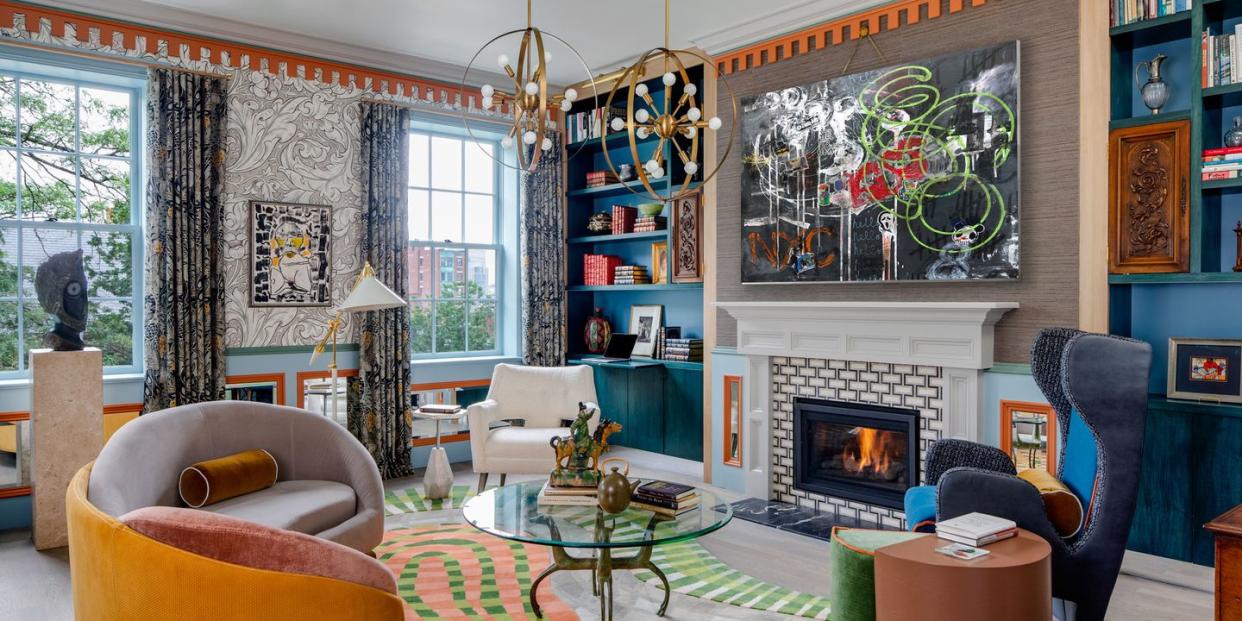This Boston Apartment Puts a Crazy-Creative Spin on Historic Details

Upon first encountering the work of Boston designer Steven Favreau, "historic detail" might not be the first word that springs to mind. Favreau, an outspoken maximalist who works out of a kaleidoscopically colored office he's dubbed the Favreaulous Factory, has developed a loyal fan base for his out-there designs, which always feature bold color, daring pattern, and a delightfully unique mix of furnishings. But in one recent project, a condo in Boston's historic Beacon Hill neighborhood, the designer demonstrates an ability to play with historic detail—and proves that the classics can be bold.
In spite of her old-school neighborhood,"my client wanted someone who didn't do 'traditional Boston,'" Favreau tells House Beautiful. The client it also a seasoned traveler, and her collection included a trove of art and objets that she's amassed around the globe. Favreau's task: update her historic home—without gutting it—and incorporate the treasures of her travels.
Though the condo dated to about 1902, it had gone through several rounds of renovations by various developers who had winnowed down its original charm. "While the developer did a nice job, it was it was very whitewashed," says Favreau (who admits that's far from his style, calling himself "over the top and theatrical").

"It had some crown molding, but very, very little," he recalls. "And so I talked to her about the idea of interpreting traditional molding and architectural elements, but perhaps giving them a little bit of a spin. I love to look at historic places, and maybe blow up the size or play with color in a way that wouldn't have been that way over 100 years ago. So that was sort of the starting point."
First up, blowing out small crown molding into oversized dentil, playing up the scale of its rectangular blocks. "There's a lot of dentil molding in that style outside the building, so I brought her some photos and said, 'How about this?' She said, 'Oh, that's beautiful,'" Favreau recalls. "Then I said 'Okay, well, how about if it's four and a half inches?'"

Miraculously, the client was on board—and then Favreau brought up the idea of painting them orange. "You have to just keep pushing,'" he laughs. She went for it, though, and the result is a unique detail that spans modern and traditional.
It's the perfect cap to a room that's full of bold choices, yet still incorporates history—without feeling overwhelming. "I have this personal mission to challenge my fellow designers to to get their clients to to be edge of where their comfort zone is," says Favreau. "People ask, 'How can you possibly have eight patterns and colors all happening?' I believe that there is an interesting synergy that happens when you put patterns and colors together that aren't so obvious. It almost becomes peaceful."

In the living room, a coffee table found on 1stdibs is surrounded by furniture Favreau had custom-made with a fabricator in Albania, all atop a custom rug from Pakistan. Robert Allen draperies and William Morris wallpaper lend additional patterns, and a painting by artist Joseph Dermody hangs over the mantel.
The kitchen has a similar mix of eras, with more traditional floral wallpaper offsetting custom cabinetry and a terrazzo pattern designed by Favreau. The showstoppers of the room, the cabinets themselves exhibit this juxtaposition: Their multi-material, graphic design feels wholly modern, but they were handmade by a skilled fabricator in Massachusetts.

In a similar vein, an 1880s oil painting (complete with traditional gilded frame) in the foyer is hung over a quartet of mirrors overlooking a modern light fixture. Meanwhile, in the bedroom, a futuristic full-wall headboard treatment in smooth leather stands in contrast to a pair of antique Indonesian wood doors.
"It's that juxtaposition of old and new because my theory on old and new is when you put them together, they elevate each other," says the designer.
You Might Also Like
